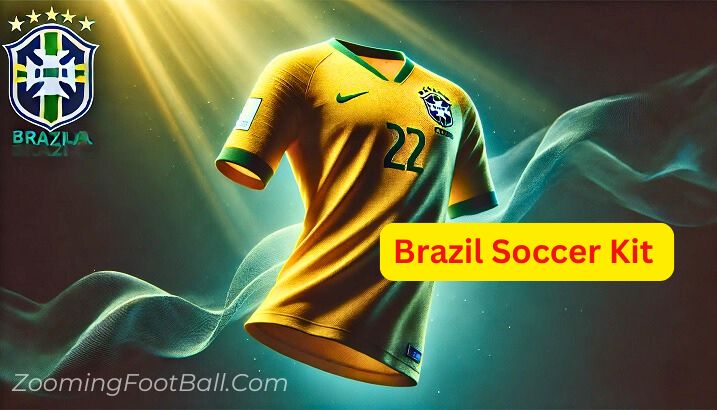Introduction Brazil Soccer Shirt
Brazil Soccer Shirt. From the ashes of the 1950 Maracanazo disaster to its status as a global fashion icon, Brazil’s yellow jersey is more than a uniform—it’s a cultural manifesto. Worn proudly by the Seleção Canarinho (Brazilian National Team), the yellow jersey has evolved from a symbol of redemption to a representation of national pride.
This iconic kit has played a key role in defining Brazil‘s footballing legacy and global influence. The story behind the Brazilian Yellow Jersey is one of resilience, evolution, and a constant connection to the nation’s identity.
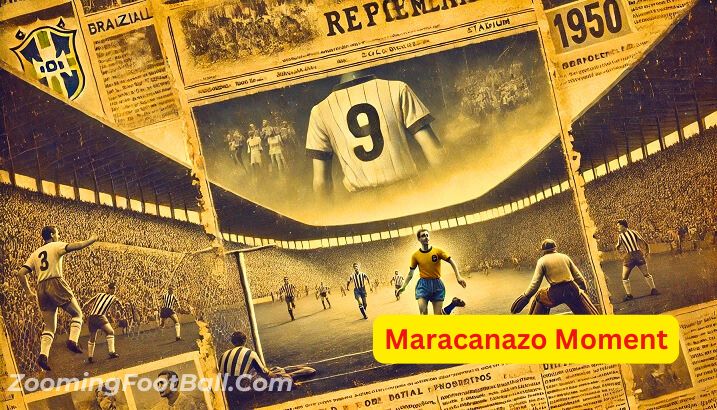
The history of Brazil‘s yellow jersey spans decades, filled with dramatic shifts in design, political significance, and its profound cultural impact. The 1950 World Cup (known for the Maracanazo) played a crucial role in the decision to adopt this vibrant color.
Over the years, the jersey has become synonymous with victory, with Pelé’s 1970 World Cup win marking the height of its cultural symbolism. Today, it continues to evolve with each new generation of players, keeping its iconic status intact.

Origins of the Brazil Yellow Soccer Shirt: From Tragedy to Triumph
Why Did Brazil Switch to Yellow soccer kit?
In the aftermath of Brazil’s humiliating 1950 World Cup loss, known as the Maracanazo, the national team needed a fresh start. Prior to this, Brazil played in white kits, but the emotional blow of the Maracanazo led to a change in colors.
In 1953, Aldyr Garcia Schlee won a design competition, changing the Brazilian national team’s colors to yellow and green. These colors represented hope and renewal, embodying the resilience of the Brazilian people. The Brazilian Yellow Jersey was born, and it became a symbol of a brighter future for the nation’s football team.
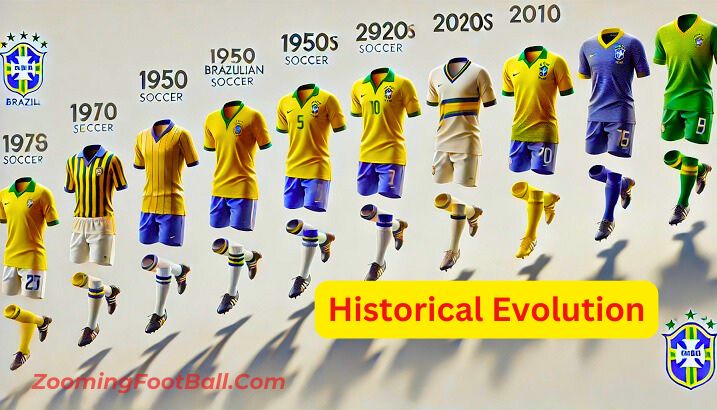
The First Brazil Yellow Jersey Soccer Match
The first time the Brazilian Yellow Jersey was worn in a match was in 1954. It was a turning point, marking the beginning of a new era for Brazilian football. This was the start of a winning tradition that would see Brazil become one of the most successful teams in World Cup history.
The jersey itself had simple yet powerful symbolism: yellow represented the sun and joy, while green symbolized the lush forests and natural beauty of Brazil. The adoption of these colors was not only a fresh visual identity but also a sign of hope and strength for the nation.
Evolution of Design of Brazil Soccer Shirt: Decades of Innovation
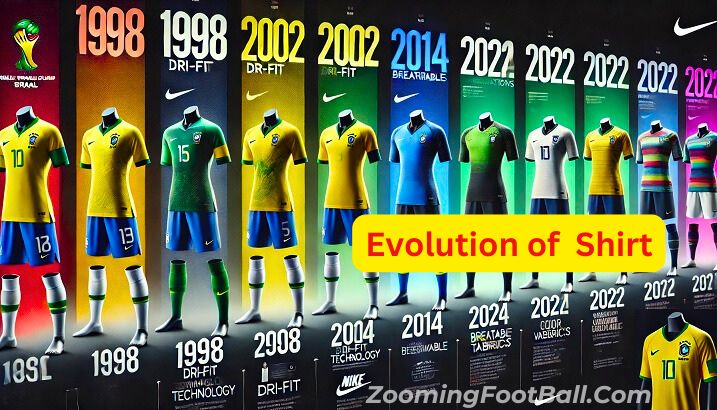
1950s–1970s: The Golden Era of Brazil Soccer Shirt
The Brazilian Yellow Jersey became famous worldwide during the 1958 World Cup, where Brazil secured its first victory. This was followed by their triumph in 1970, with Pelé leading the charge. The 1970 World Cup jersey remains one of the most iconic in football history, representing Brazil’s dominance in the sport.
The design was simple yet elegant, with the famous Canarinho (Little Canary) yellow shining brightly on the field. The jersey’s enduring legacy comes not just from the victories but also from how it connected Brazil’s football heritage with the country’s larger cultural identity.
1980s–2000s: Sponsorships & Modernization of Brazilian futebol camisa
By the 1980s and 1990s, the design of the Brazil national team jersey began to change to incorporate modern fabrics and sponsorship logos. In 1994 and 2002, Nike became the official sponsor of Brazil‘s national team, marking the start of a new partnership that would define the look of Brazil‘s kits for decades.
The iconic Nike x Brazil collaboration led to the creation of Brazilian Soccer Shirts with advanced technology, like moisture-wicking fabrics. However, while the Soccer Shirts became more modern, the colors of yellow and green remained central to Brazil‘s identity.
2020s and Beyond: Tech & Trends of Brazil Soccer Shirt
As we enter the 2020s, Brazilian Soccer Shirts have become more sustainable, with many using eco-friendly materials like recycled fabrics. The technology in these Brazilian Soccer Shirts continues to evolve, with innovations such as cooling fabrics and lighter, more breathable materials.
These new designs still keep the historical yellow gold of Brazil’s jersey at the forefront, ensuring that the rich cultural heritage of the kit is not lost in the pursuit of modernity.
At the same time, there has been a rise in fan-inspired designs that allow supporters to feel even more connected to their team.
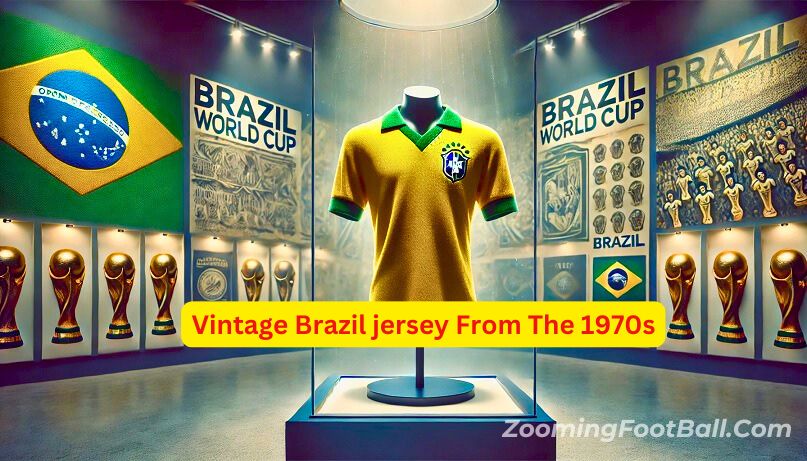
Chart: Design Evolution of Soccer Shirt of Brazil
| Year | Design | Notable Players |
| 1958 | Classic Yellow, Green Collar | Pelé, Garrincha |
| 1970 | Simplified Round Neck | Pelé, Jairzinho |
| 1994 | V-neck, Subtle Patterns | Romário, Bebeto |
| 2002 | Mesh Design, Unique Panels | Ronaldo, Rivaldo |
| 2014 | Slim Fit, Modern Tech | Neymar, Thiago Silva |
| 2022 | Bold Prints, Tribute to Past | Vinícius Jr., Richarlison |
Table: Brazilian Yellow Soccer Shirt’s Design Evolution
| Year | Designer | Key Design Changes | Historical Context |
| 1953 | Aldyr Garcia Schlee | Yellow and green colors introduced | Post-Maracanazo, a symbol of national pride and renewal |
| 1958 | CBF and National Team | Iconic Yellow jersey worn during World Cup | 1st World Cup win with the iconic Amarelinha |
| 1970 | Nike x CBF | Innovation in fabric and design, iconic #10 Pelé jersey | Legacy of Pelé’s role in football history |
| 2002 | Nike | “8-Star” design with Ronaldo and team victory | Brazil’s 5th World Cup win, a modern take on tradition |
Symbolism & Cultural Impact of Seleção Brasileira Uniform: Beyond the Pitch
National Identity & Democracy in Brazil Soccer Shirt
The Brazilian Yellow Jersey is more than just a piece of sportswear. It’s deeply intertwined with Brazilian identity and national pride. The jersey’s colors are not just for the pitch; they are symbols of Brazil‘s unique culture and its people’s resilience.
In the 1980s, when Brazil transitioned from a military dictatorship to democracy, the yellow jersey became a symbol of freedom and hope for the future. Even during political unrest, the jersey remained a symbol of unity and national identity.
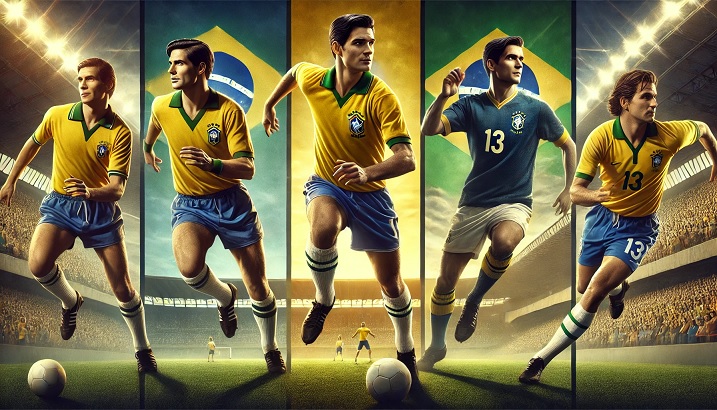
Political Controversies
Over the years, the Brazilian Yellow Jersey has also been involved in political debates. The 2014 World Cup saw the jersey’s colors appropriated by different political factions, sparking debates over national unity versus political symbolism.
Despite these controversies, the Brazil national team jersey has largely remained a unifying symbol for the nation, transcending politics to become a cultural icon.
Global Influence of Brazil Soccer Shirt
Globally, Brazil’s football kit has inspired countless other teams. The influence of the Brazilian national Soccer Shirt can be seen in the designs of teams like Cameroon, who adopted sleeveless kits in 2002, following the global trend set by Brazil.
The Museu do Futebol in São Paulo showcases many of these Soccer Shirts, celebrating the profound impact Brazil‘s iconic kits have had on Soccer fashion and culture around the world.
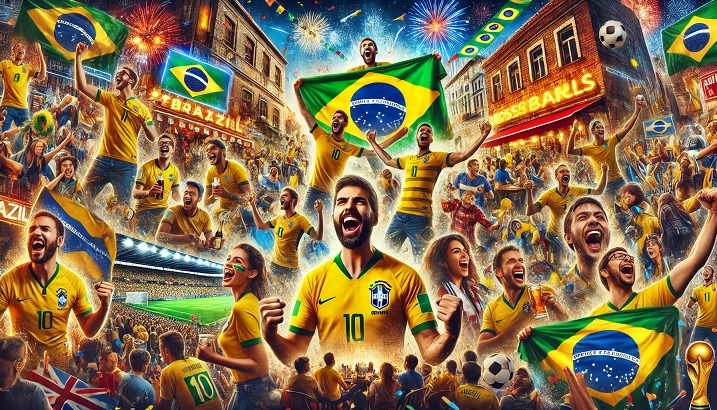
Iconic Moments & Legendary Players
World Cup Glory
Throughout the history of the Brazilian Yellow Jersey, there have been moments of triumph that have defined the world’s most successful football team. The 1970 World Cup, with Pelé wearing his famous yellow jersey, is perhaps the most iconic of all.
Later, Romário’s 1994 victory and Ronaldo’s 2002 World Cup win, wearing Brazil’s 8-star jersey, further cemented the Brazilian Yellow Jersey as a symbol of World Cup glory.

Each World Cup victory is not just a football achievement, but a reaffirmation of Brazil’s color symbolism and its place in football history.
Chart: Brazil World Cup Wins
Brazil’s Iconic World Cup Wins (1958–2002)
| Year | Star Player | Key Achievement |
| 1958 | Pelé | 1st World Cup win, Golden Boot |
| 1970 | Pelé | 3rd World Cup win, 5 Stars |
| 2002 | Ronaldo | Fifth World Cup win, 8-Star jersey |
Heartbreaks & Redemption
Despite the glory, there have been moments of heartbreak. The 2014 World Cup saw Brazil’s national team suffer a devastating 7-1 loss to Germany. This loss, while tragic, didn’t diminish the emotional connection Brazilians had with their national jersey.
It showed the deep cultural symbolism that the jersey holds—representing both victory and the resilience to bounce back, even in defeat.
Women’s Soccer Influence
While the Brazilian Yellow Jersey is most famously associated with the men’s team, it is also a powerful symbol for Brazil‘s women’s national team.
Marta, one of the greatest female footballers of all time, has worn the yellow jersey proudly, helping bring attention to women’s football.
As women’s soccer continues to grow globally, the Brazilian national team jersey has become a symbol of progress, equality, and the continued fight for gender inclusivity in sports.
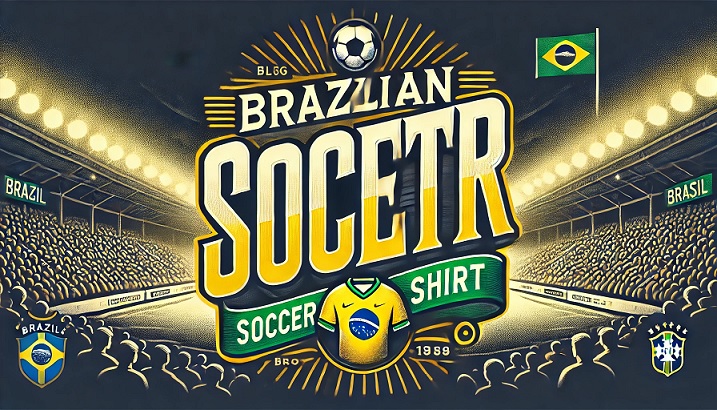
The Business of the Jersey: Commerce & Collecting
The Brazilian Yellow Soccer Shirts isn’t just a symbol of national pride; it’s also a major business commodity. Over the years, it has become a key player in both commercial sales and memorabilia collecting.
Through strategic partnerships and a thriving collector’s market, the jersey has expanded beyond the Soccer field and into the broader world of commerce.
Guinness World Record Collections
The Brazil Soccer Shirt has also earned a spot in the world of Guinness records. Paulo Figueiredo, a Brazilian collector, holds the Guinness World Record for having the largest Soccer Shirt collection, with an impressive 2,000+ Soccer Shirts from various countries and players.
Figueiredo’s soccer memorabilia collection includes multiple Brazil Soccer Shirt, some of which are rare, vintage editions.
His collection doesn’t just include Soccer Shirts from the Seleção but also from famous matches, such as the 1958 World Cup victory and Pelé’s 1970 World Cup jersey.
His recognition for his Guinness soccer collection highlights how the Brazilian Yellow Soccer Shirt isn’t just a piece of fabric—it’s an item of historical significance and emotional value.
Collectors like Figueiredo take pride in preserving rare Soccer Shirts that tell the story of Brazilian football, its legends, and iconic moments like the Maracanazo. The emotional attachment fans have to these Soccer Shirt s makes them incredibly valuable, both financially and sentimentally.
Retro Brazil shirts—especially those worn during monumental matches—continue to attract high demand, underscoring the timeless appeal of Brazil’s football heritage.
Fan Culture & Nostalgia
Fan culture around the Brazilian Yellow Soccer Shirt thrives on nostalgia. With some of football’s most legendary players wearing it, fans eagerly collect Soccer Shirts tied to historic moments.
A 1990 Maradona match-worn Soccer Shirt can fetch a fortune among collectors, just like jerseys from Pelé, Romário, and Ronaldo, each symbolizing Brazil’s World Cup triumphs. These retro kits serve as a connection to cherished childhood memories and unforgettable matches.
Beyond player appeal, the Brazilian Yellow Soccer Shirt holds deep cultural significance, transcending sports to become a national symbol. Whether worn at the World Cup or as casual streetwear, it represents pride and passion for Brazilian football.
More than just sportswear, the Amarelinha has evolved into iconic memorabilia, influencing sponsorships, sales, and Guinness World Record collections. Whether for collectors, nostalgic fans, or football enthusiasts, the Brazil Soccer Shirt remains a timeless emblem of heritage and excellence.
Nike’s Role and Modern Trends in Brazil’s Footballing Garb

Nike and the Brazilian Football Confederation (CBF)
Nike’s partnership with the Brazilian Football Confederation (CBF) has been one of the most influential collaborations in the world of sports apparel. Since 1998, Nike has designed and produced Brazil’s national team kits, providing innovative and performance-oriented gear for the legendary Seleção Canarinho.
This collaboration has resulted in some of the most iconic Brazilian Soccer Shirts, blending cutting-edge technology with cultural pride. Over the years, Nike has continuously enhanced the Soccer Shirt‘s design and functionality, ensuring Brazil‘s football team remains at the forefront of style and performance.
A key factor in this partnership’s success is Nike’s ability to integrate advanced technology into the kits, making them lightweight, breathable, and more suited for high-intensity games. From Dri-FIT fabric to moisture-wicking technology, these Soccer Shirts allow players to stay cool and comfortable during matches. This approach to performance innovation is crucial in maintaining Brazil’s competitiveness on the world stage.
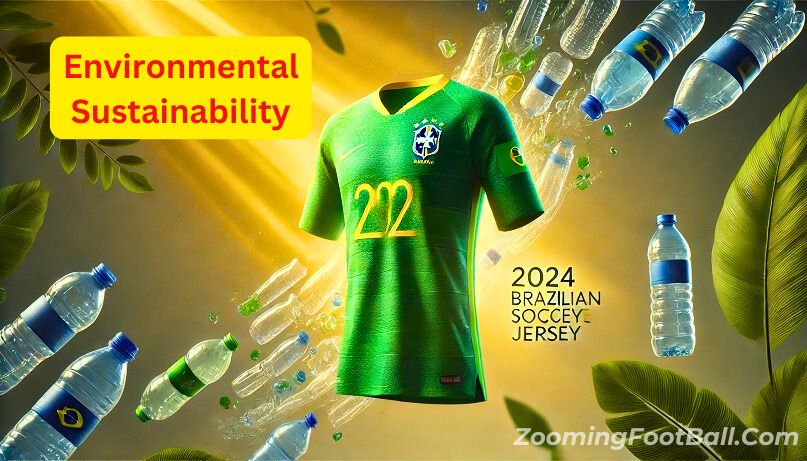
Sustainable Jersey Production
Nike has also pioneered sustainable Soccer Shirt production, which is becoming a major trend in sportswear. In recent years, the company has used recycled materials to create its Soccer Shirts, including those worn by the Seleção.
This eco-friendly approach aims to reduce the environmental footprint of football apparel, which traditionally requires a lot of resources and energy. For instance, Nike‘s recycled polyester Soccer Shirts are made from plastic bottles, reducing waste and promoting environmental sustainability.
As green initiatives gain importance worldwide, Nike’s adoption of these practices positions them as leaders in the sustainability movement in sports apparel. Their sustainable Brazil kits reflect both the brand’s commitment to preserving the planet and their ongoing dedication to the national team’s identity.
Fans can wear their Soccer Shirts with pride, knowing they are supporting a brand that values both performance and environmental responsibility.
Player-Specific Brazil Soccer Shirt
Another modern trend is the rise of player-specific Soccer Shirts, allowing fans to buy replicas worn by their heroes, such as Pelé, Ronaldo, and Neymar. These Soccer Shirts are not only iconic but are also tailored to represent the achievements and legacy of Brazil‘s football legends.
By offering these limited-edition Soccer Shirts, Nike connects fans to their favorite players and creates a sense of personal connection with the national team. This trend has also led to the growth of a dedicated fan base that embraces collecting Soccer Shirts worn by Brazilian football legends.
It allows fans to wear a piece of history, whether it’s a retro design from Pelé’s 1970 World Cup triumph or the 2002 World Cup Soccer Shirts worn by Ronaldo. Player Soccer Shirts have become more than just a kit—they symbolize national pride and the football heritage that runs deep in Brazil.
Retro Kit Trends
The nostalgia for Brazil‘s retro football kits is also a significant part of Nike’s strategy. By re-releasing vintage designs, Nike taps into the deep connection that Brazilian fans have with their footballing past. Soccer Shirts from the 1970 World Cup or the 1994 World Cup are highly sought after by collectors and passionate fans alike.
These retro kits allow fans to relive the glory days of Brazilian football, and Nike has effectively turned these classic designs into collector’s items.
Nike‘s skill in blending modern technology with timeless design has made Brazil‘s kits not just a piece of sportswear, but a part of global culture.
The popularity of these retro kits continues to grow as fans seek to wear a symbol of their pride in their country’s footballing legacy.
In conclusion, Nike’s collaboration with the Brazilian Football Confederation has transformed Brazil’s football kits into a powerful mix of performance, heritage, and modern design. With sustainable production practices, player-specific Soccer Shirts, and a focus on retro kit trends, Nike has ensured that the Seleção’s Soccer Shirts continue to represent Brazil’s football heritage while embracing the future of sportswear.
The Future of the Canarinho’s legendary strip
As Brazil’s national football team moves forward, the future of the Brazilian Yellow Jersey—or the Amarelinha—looks bright, but also filled with innovation and new challenges. Designs are evolving, but the cultural relevance of the jersey remains rooted in history.
Will the classic yellow ever change, or is tradition too powerful to let go of? Here’s a closer look at the future of the Canarinho and what lies ahead for one of football’s most iconic symbols.
Design Innovations of Brazil Soccer Shirt
Design innovations undoubtedly shape the future of Brazil football trends, aiming to improve both performance and style. Modern Brazil Soccer Shirts already embrace new technologies that enhance comfort and durability, and the next generation will introduce even more advanced features.
Nike, as the official kit supplier, has pioneered many of these changes, including the introduction of cooling fabrics, moisture-wicking textiles, and breathable materials that allow players to perform at their best, regardless of the temperature.
Tech integration in future Seleção designs is set to revolutionize the way players experience their Soccer Shirts. For example, cooling fabrics that regulate body temperature could make a huge difference in intense matches under the Brazilian sun.
These fabrics adapt to the body’s heat, providing comfort and performance advantages that can help players maintain focus throughout the game. Additionally, Nike’s Dri-FIT technology, which wicks moisture away from the skin, is already present in the current kits and is likely to evolve even further, providing greater flexibility and breathability.

Moreover, we could see the integration of sustainable materials in Brazil football trends. As environmental concerns continue to rise, the move towards recycled fabrics and eco-friendly jersey designs is likely to gain momentum.
Just as Nike introduced sustainable kits in previous years, the future may see more Brazil Soccer Shirts crafted from recycled ocean plastics or other environmentally responsible materials, allowing fans and players to support both the team and the planet.
Cultural Relevance of Samba Squad’s signature colors
One of the strongest elements of the Brazilian Yellow Jersey is its cultural significance. As the world of football continues to evolve, so too does the way Brazil football trends interact with youth engagement and social media.
The digital age increasingly shapes the younger generation’s connection to the Seleção Canarinho, as fans actively engage with their favorite players and teams on platforms like Instagram, TikTok, and Twitter.
Youth engagement is key to the future of the Brazilian Yellow Jersey, as social media plays an ever-growing role in how fans interact with the sport. Instagram hashtags like #Amarelinha and TikTok trends featuring Brazilian national team players show just how deeply football has embedded itself in Brazilian culture.
Fans now share their Soccer Shirts, participate in viral challenges, and follow every match with unprecedented levels of enthusiasm. Social media allows for a more personal connection to the jersey, with fans customizing and sharing their own interpretations of the Seleção kits.
The future of the Brazilian Yellow Jersey also hinges on how Brazilian football culture adapts to the fast-paced digital environment. From live-streamed matches to exclusive behind-the-scenes content, the jersey will likely continue to be a part of this dynamic, as younger fans look for new ways to interact with their national team and the Soccer Shirts they wear.
Will the Colors Change of Five-star kit?
One of the biggest debates surrounding the future of Brazil Soccer Shirts is whether the iconic yellow color will ever change. The Brazil national team’s jersey is deeply tied to the country’s identity, heritage, and football passion.
Some believe the classic yellow and green must remain to preserve national identity and football heritage, while others argue that fresh designs could attract younger fans and global attention.
The Brazilian Yellow Jersey has been worn by legends like Pelé, Ronaldo, and Neymar, symbolizing five World Cup victories. Changing it could weaken that historical connection. However, history shows that football jerseys evolve, as seen in the 1953 redesign that introduced the yellow shirt.
Future Seleção designs will likely keep the classic colors but may incorporate modern updates, such as new cuts, collars, and technology. With Nike’s partnership, Brazil’s jerseys could blend tradition with innovation to enhance performance and style.
No matter how the Amarelinha evolves, it will always unite fans, players, and the nation, remaining a symbol of Brazil’s football excellence.
Fun Facts about the Brazilian Yellow Jersey
The Color Was a National Statement:
After the 1950 World Cup loss (Maracanazo), Brazil‘s national team switched from wearing white Soccer Shirts to the iconic yellow. The yellow jersey was chosen as a symbol of optimism and pride, transforming from a football kit to a symbol of national unity and strength.
A Designer’s Vision:
The yellow jersey design was chosen through a national competition in 1953, won by Aldyr Garcia Schlee. What makes this unbelievable is that Schlee was just 19 years old when he created the design that would define Brazil‘s identity on the global football stage for decades.
A Change in Every Era:
The Brazilian Yellow Jersey has undergone several significant design changes throughout the years. For example, the 1970 World Cup jersey is one of the most iconic football kits of all time, worn during Brazil‘s legendary victory with Pelé. It featured the famous V-neck collar and was the first jersey to display the five stars representing Brazil’s World Cup victories.
Pelé Made the Yellow Jersey Famous:
The Brazilian Yellow Jersey became internationally iconic largely because of Pelé, who wore it during the 1958, 1962, and 1970 World Cups. He is still considered the greatest player to ever wear the jersey, making it synonymous with greatness. You may also like this: Top 10 Most Expensive Players
The Star-Studded Design:
The five stars on Brazil’s jersey represent their World Cup victories, but did you know that the number of stars has actually caused debates? Some Brazilian fans initially wanted to add more stars for regional and national achievements, but the CBF (Brazilian Football Confederation) has always kept it simple: five stars for five World Cup wins. You may also like this: The Invention of Soccer: Who, Where, and When It Was Invented
More Facts about Brazil Soccer Shirt
The Yellow Jersey Wasn’t Always Welcome:
The yellow jersey was initially controversial. Many Brazilians didn’t accept the new color after the 1950 World Cup loss. Some even thought the jersey change was a bad omen, associating the yellow color with defeat. But over time, it became a symbol of Brazil’s football heritage and national pride.
The Amarelinha Nickname:
The famous nickname for Brazil‘s yellow jersey is Amarelinha, meaning “Little Yellow”. Fans and players alike adopted this nickname as a term of endearment for their iconic kit, which is now recognized worldwide. You may also like this: Types of Soccer Ball
The Historical Museum of Football:
At the Museu do Futebol in São Paulo, you can find an Amarelinha from almost every World Cup and national team tournament. The museum is a treasure trove of Brazilian football artifacts, showcasing how the Brazilian Yellow Jersey has evolved over time and become a cultural symbol.
The Shirt Is a Celebrity in Itself:
The Brazilian Yellow Jersey is not only famous in Brazil. The Brazilian Yellow Soccer Shirt stands as a global symbol of football excellence, with legends like Romário, Ronaldo, Neymar, and Zico proudly wearing it. Films, documentaries, and fashion shoots have also showcased its impact, proving how football culture transcends sports. You may also like this: History of Soccer Ball
A Jersey that Inspired a Revolution:
Brazil’s transition from white to yellow Soccer Shirts after the Maracanazo wasn’t just a change in kit design. It represented a national rebirth, leading to a new era in Brazilian football. This change marked the beginning of a dominant period in football history, with Brazil’s footballing culture becoming globally recognized. You may also like this: What Does FIFA Stand For?
Conclusion: Brazil Soccer Shirt
The Brazilian Yellow Jersey is not just a symbol of a football team; it is a representation of Brazil itself—its history, pride, and culture. From its origins in the 1950 World Cup to its modern-day status as a global icon, this jersey has been worn by legends, celebrated by fans, and cherished as a piece of Soccer heritage. You may also like this: Rules Of Soccer
Whether you are wearing it to show your support, collecting it as a piece of history, or simply appreciating its significance, the Brazilian national team jersey will always be a symbol of national unity and cultural pride.
What is your favorite Brazil jersey moment? Share your story with us in the comments!
FAQs about the Brazil Soccer Shirt
Why is Brazil’s football jersey yellow?
Brazil‘s football jersey became yellow following the 1950 World Cup loss (the Maracanazo). The 1953 design competition introduced the yellow jersey as a symbol of national pride and renewal, with Aldyr Garcia Schlee as the designer. The yellow color represents Brazil‘s national identity and optimism.
What does the yellow jersey symbolize?
The yellow jersey symbolizes Brazil‘s unity, national pride, and connection to their football heritage. The color was chosen to reflect Brazil’s national colors and represent hope and joy after the heartbreak of the 1950 World Cup. You may also like this: The Best Soccer Leagues in the World
Why does Brazil wear a green and yellow kit?
The combination of yellow and green represents Brazil’s flag and national colors. The green stands for the country’s lush forests, while the yellow symbolizes wealth and the gold that the country is famous for.
Who designed Brazil’s iconic yellow jersey?
Brazil’s iconic yellow jersey was designed by Aldyr Garcia Schlee in 1953 following a national competition. The jersey became a symbol of resilience after the 1950 World Cup loss.
More FAQs about Brazil Soccer Shirt
What is the significance of the five stars on Brazil’s jersey?
The five stars on Brazil’s jersey represent their five World Cup victories: 1958, 1962, 1970, 1994, and 2002. Each star is a reminder of Brazil‘s legendary footballing history and success on the world stage.
How has the design of Brazil Soccer Shirt evolved over the years?
Brazil’s yellow jersey has evolved in design and fabric since 1953. While the yellow and green colors have remained constant, Nike now creates modern soccer shirts with advanced materials, focusing on performance, comfort, and sustainability. You may also like this: Messi Soccer Kits: The Ultimate Guide
What is the historical impact of the Brazilian Soccer Shirt?
The Brazilian yellow jersey has become a global symbol of football excellence, representing Brazil’s culture, footballing traditions, and national pride. Its significance extends beyond just the sport, influencing fashion, art, and society. You may also like this: Craig Johnston Soccer Legend, Innovator & Visionary

Oliver Brown, a seasoned football blogger with a knack for insightful commentary, brings decades of passion and expertise to Zooming Football. Known for his sharp analysis and engaging storytelling, Oliver delves deep into the game’s nuances, offering readers a unique perspective on football’s most captivating stories and strategies.

